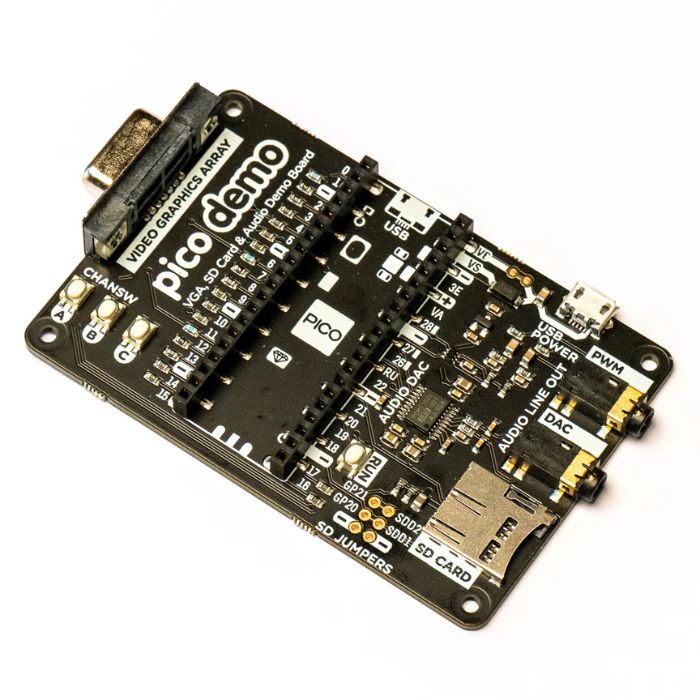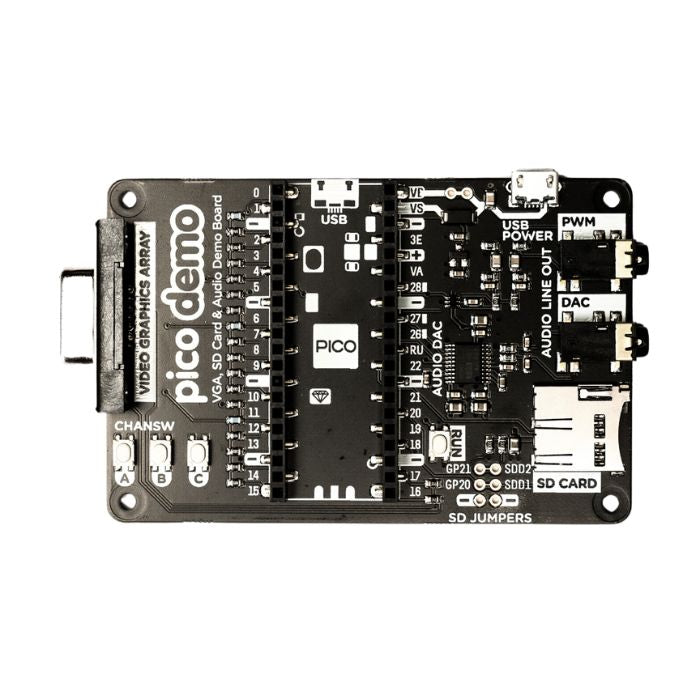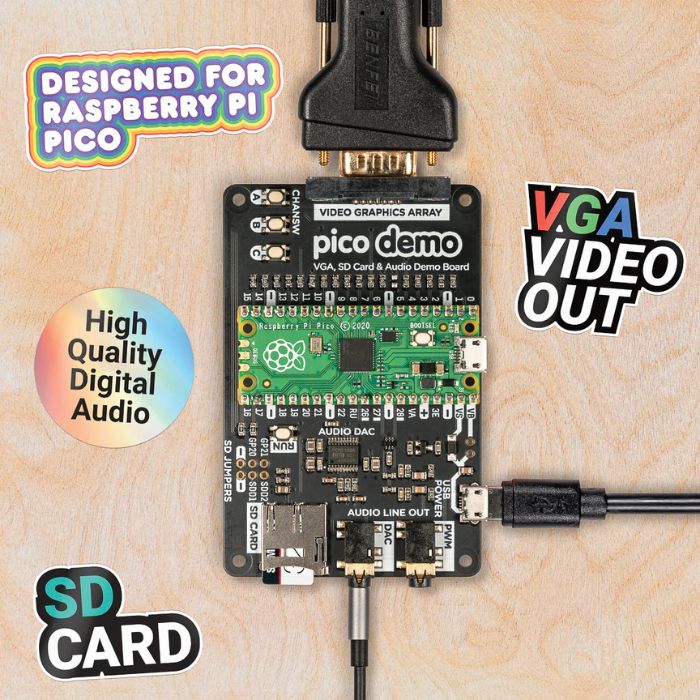Dieses Board wurde speziell entwickelt, um den kostengünstigen, funktionsreichen RP2040-Chip auf dem Raspberry Pi Pico zu präsentieren. Es verfügt über einen VGA-Ausgang, einen SD-Kartenslot, einen digitalen I2S-Audioausgang und vieles mehr!
Basierend auf dem Referenzdesign von Raspberry Pi, ist unsere Pimoroni Pico VGA Demo Base eine großartige Möglichkeit, um mit dem Raspberry Pi Pico/RP2040 zu experimentieren. Es ist der perfekte Weg, um einige der lustigen Dinge zu demonstrieren, die Sie mit dem RP2040 Mikrocontroller erreichen können, wie z.B. die Erzeugung einer soliden VGA-Ausgabe, ohne die CPU überhaupt zu belasten!
Verblüffen Sie Ihre Freunde, indem Sie ihnen zeigen, dass Sie noch ein D-Sub-Kabel besitzen!
Erfreuen Sie sich an der Herrlichkeit von 15-Bit-Analogvideo!
Erfreuen Sie sich an dem warmen, authentischen, RC-gefilterten PWM-Audio!
Auf diesem Board laufen die verschiedenen Video-Beispielprogramme, die Raspberry Pi zusammengestellt hat, um die Funktionen des RP2040 zu demonstrieren.
Bitte beachten Sie, dass die VGA Demo Base derzeit nur mit dem C/C++ Pico SDK funktioniert!
Ein Raspberry Pi Pico ist nicht im Lieferumfang enthalten - Sie können den Raspberry Pi Pico direkt bei uns kaufen.
Ihr Pico muss mit Stiftleisten angelötet werden (mit den Pins nach unten), um an unsere Zusatzplatinen angeschlossen werden zu können.
Merkmale
- 15-poliger VGA-Anschluss
- PCM5100A DAC für Line-Out-Audio über I2S (Datenblatt)
- PWM-Audio-Ausgang
- SD-Karten-Steckplatz
- Reset-Taster
- Buchsenleisten für die Installation Ihres Raspberry Pi Pico
- Drei vom Benutzer steuerbare Schalter
- Gummifüße
- Kompatibel mit Raspberry Pi Pico
- Kein Löten erforderlich (solange Ihr Pico über Stiftleisten verfügt)
- Programmierbar mit C/C++
Erste Schritte
Die Pinbelegung unserer Platine ist die gleiche wie die der Raspberry Pi Referenzplatine. Sie finden sie in Kapitel 3 von Hardware Design with RP2040 zusammen mit weiteren allgemeinen Informationen über die VGA-Referenzplatine.
Um die Audio- und Videobeispiele in den experimentellen Repos des Raspberry Pi ausführen zu können, müssen Sie zunächst sicherstellen, dass Sie aktuelle Versionen von pico-extras und pico-playground haben. Wenn Sie die Beispiele bauen, müssen Sie die Boardkonfiguration angeben, damit die Beispiele die richtigen Pins verwenden. Sie können dies tun, indem Sie ein neues Build-Verzeichnis erstellen und dann die Board-Definition bei der Verwendung von cmake angeben:
cmake -D "PICO_BOARD=vgaboard" ...
Weitere Details zum Erstellen von Anwendungen mit benutzerdefinierten Boardkonfigurationen finden Sie in Anhang D / Seite 267 der C/C++ SDK-Dokumentation.
English Descpriction
This board is specifically designed to showcase the low-cost,
feature-rich RP2040 chip on the Raspberry Pi Pico. It has a VGA
output, SD card slot, I2S digital audio output and much more!
Based on Raspberry Pi's reference design, our Pimoroni Pico VGA
Demo Base is a great way to experiment with the Raspberry Pi
Pico/RP2040. It's the perfect way to demonstrate some of the fun
things you can accomplish with the RP2040 microcontroller, such
as producing solid VGA output without putting a strain on the CPU
at all!
Amaze your friends by showing them that you still have a D-Sub
cable! Enjoy the glory of 15-bit analog video! Enjoy the warm,
authentic, RC filtered PWM audio! This board runs the various
video sample programs that Raspberry Pi has put together to
demonstrate the features of the RP2040.
Please note that the VGA Demo Base currently only works with the
C/C++ Pico SDK! A Raspberry Pi Pico is not included - you can buy
the Raspberry Pi Pico directly from us. Your Pico needs to be
soldered with headers (pins down) to connect to our add-on
boards.
Characteristics
Amaze your friends by showing them that you still have a D-Sub
cable! Enjoy the glory of 15-bit analog video! Enjoy the warm,
authentic, RC filtered PWM audio! This board runs the various
video sample programs that Raspberry Pi has put together to
demonstrate the features of the RP2040.
Please note that the VGA Demo Base currently only works with the
C/C++ Pico SDK!
A Raspberry Pi Pico is not included - you can buy the Raspberry
Pi Pico directly from us. Your Pico needs to be soldered with
headers (pins down) to connect to our add-on boards.
15-pin VGA connector
PCM5100A DAC for Line-Out Audio over I2S (Datasheet)
PWM audio output
SD card slot
Reset button
Female headers for installing your Raspberry Pi Pico
Three user-controlled switches
Rubber feet
Compatible with Raspberry Pi Pico
No soldering required (as long as your Pico has headers)
Programmable with C/C++
Getting Started
The pinout of our board is the same as that of the Raspberry Pi
reference board. You can find it in Chapter 3 of Hardware Design
with RP2040 along with other general information about the VGA
reference board.
In order to run the audio and video samples in the experimental
repos of the Raspberry Pi, you must first make sure that you have
current versions of pico-extras and pico-playground. When you
build the samples, you must specify the board configuration so
that the samples use the correct pins. You can do this by
creating a new build directory and then specifying the board
definition when using cmake:
cmake -D "PICO_BOARD=vgaboard"...
For more details on building applications with custom board
configurations, see Appendix D / page 267 of the C/C++ SDK
documentation.
Sicherheitsangaben
- Lesen Sie die Bedienungsanleitung sorgfältig durch, bevor Sie das Produkt verwenden.
- Stellen Sie sicher, dass alle Montage- und Installationsanweisungen des Herstellers sorgfältig befolgt werden.
- Verwenden Sie das Produkt nur für den vorgesehenen Zweck.
- Die unsachgemäße Nutzung dieses Produkts kann zu schweren Verletzungen oder Sachschäden führen.
- Nicht für Kinder unter 10 Jahren geeignet.
- Bei unsachgemäßer Verwendung besteht eine Verletzungsgefahr.
- Dieses Produkt entspricht den geltenden Sicherheitsanforderungen der Europäischen Union.
- Dieses Produkt wurde gemäß der GPSR geprüft, die sicherstellt, dass alle relevanten Sicherheitsanforderungen für Konsumgüter eingehalten werden.
Nachverfolgbarkeitsinformationen
Jedes Produkt verfügt über eines oder mehrere der folgenden Merkmale:
- Ein CE-Kennzeichen, das die Einhaltung der Sicherheits-, Gesundheits- und Umweltschutzanforderungen der Europäischen Union anzeigt.
- Eine eindeutige Serien- oder Chargennummer, um die Nachverfolgbarkeit zu gewährleisten und bei Bedarf Rückrufaktionen zu unterstützen.
- Hersteller- und Importeurangaben für den Kundensupport und Sicherheitsanfragen.
Überwachung und Berichterstattung von Vorfällen
Für den unwahrscheinlichen Fall eines Produktproblems haben wir Verfahren implementiert, um:
- Kundenbeschwerden zeitnah bearbeiten.
- Schwerwiegende Vorfälle über das EU Safety Gate/RAPEX-System melden.
- Mit den Marktüberwachungsbehörden zusammenarbeiten, um die öffentliche Sicherheit zu gewährleisten.
Kontakt:
- Email: support [@] pi3g.com
- Telefon: 0341 / 392 858 40
Dieses Produkt ist vollständig mit allen geltenden EU-Vorschriften konform, um die Sicherheit unserer geschätzten Kunden zu gewährleisten.



